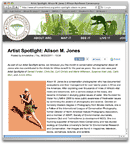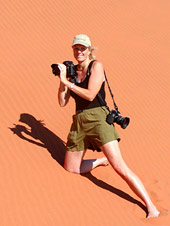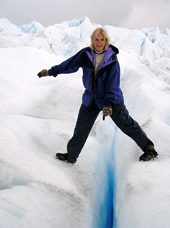
ALISON M. JONES is a conservation photographer who has documented ecosystems and their management for over twenty years in Africa and the Americas. After copiloting over thousands of miles of Africa’s vital rivers and lakeshores, with a camera always at the ready, she became immersed in studying global issues of water. She founded No Water No Life® in 2006 to raise public awareness of freshwater issues by combining the powers of photography and science. Granted an honorary Masters Degree in Photography from Brooks Institute, she is a Fellow of the International League of Conservation Photography, former Director of North American Nature Photography Association, and a member of ASMP, Society of Environmental Journalists, Explorers Club and TechnoServe (a development NGO). She is a founding supporter of Kenya’s Mara Conservancy and has studied ecology at Columbia University’s Center for Environmental Research and Conservation. Her images are found in magazines, television, books, workshops, lectures, and exhibits.

Alison Jones on Sossusvlei Dunes, Namibia
Q: Of all the places you have traveled, which resonates most with you?
A: I am always tempted to answer this question by saying “the most recent place I’ve been!” This week that would be NY’s Adirondacks State Park. Every time I visit, as I just did this August, I am struck by the Park’s deep commitment to forest conservation. Covering over 6 million acres, it is the largest park and the largest state-level protected area in the contiguous United States, and the largest National Historic Landmark.
However, Africa has certainly captivated me more than any other place. It has taught me about conservation; inspired me to pursue photography; overwhelmed me with its vast horizons and biodiversity; and motivated me to stand taller, to work harder to raise awareness of its needs and to keep returning on an almost yearly basis from my first trip there in 1985.
Climate change, deforestation and growing population numbers. These three elements are responsible for the devastating droughts, poverty, famine, health issues, and despair that haunt Africa today. Specifically for the issues No Water No Life is covering, these three elements are responsible for the lack of availability of clean fresh water and sanitation for approximately 300 million Africans!
In Tanzania specifically, No Water No Life is studying the impact of riverine deforestation and invasive plants (i.e., papyrus and water hyacinth) at the mouth of the Mara River on Lake Victoria, the effects of drought on lowering water supplies to farmers and homes, sanitation needs, and pollution both from upstream in Kenya and from local Tanzanian gold mines. However our 2009 expedition report noted: “The No Water No Life team filmed interviews with 35 stakeholders and scientists committed to mitigating these threats via better regulation of water extraction during low flows, corrective protection of the Mau Forest catchment areas, more efficient irrigation, afforestation, rain harvesting and establishment of riverine corridors. All agree that while this is certainly a critical time for the Mara River Basin, its inhabitants and its renowned wildlife, there are reasons to be positive.”
It often feels like one person can’t make a difference supporting the many environmental causes there are today. What small steps can people make to help conservation/preservation efforts in Africa or globally?
We each have to find our own niche. Mine has been to use my camera as a tool for conservation and founded No Water No Life to document six case-study African and North American watersheds. Focusing on the availability, quality and usage of our fresh water resources, we combine the powers of photography and science to raise awareness of degradation and sustainable management solutions.
What themes or personal experiences are most commonly evoked in your art?
My common themes are the beauty and values of our ecosystems; understanding the universality of all cultures in their basic needs and values while celebrating our differences; and documenting the human footprint on this earth.

Photo © Tim Lapage
What are you currently working on?
As Founder and Director of No Water No Life, I am continuing to research and document our six case-study watersheds: Africa’s Nile, Mara and Omo River Basins and North America’s Mississippi, Columbia and Raritan River Basins. These basins present most of the major freshwater issues today in both developed and developing nations: ie: deforestation, resource extraction, pollution, infrastructure and climate change. The expeditions I lead for this project create still and video imagery for educational use. Interviews with local stakeholders, scientists and stewards are filmed and transcribed for wide dissemination via our website, social and print media, lectures and exhibits.
• In September, I will be in the Columbia River Basin documenting the world’s largest dam removal thus far; a lecture in British Columbia on the transboundary issues involved in renegotiation of the Columbia River Treaty in 2014; and a reparation ceremony between the Chinook Nation and Lewis and Clark descendants who will return a replica of a canoe stolen by that expedition sponsored by President Jefferson 200 years ago.
• In October, I hope to be in the Lower Mississippi River Basin documenting the after-effects of this spring’s historic floods that were released by the US Army Corps of Engineers into the Atchafalaya Basin.
• In January, February and March, I will be in East Africa to further document our case-study watersheds there. I plan to visit the pastoralist communities around Lake Turkana whose livelihoods are threatened by the Gibe Dams Ethiopia is building on the Omo River. I will return to Kenya’s Mau Forest, headwaters of the Mara River and others, to investigate the reforestation efforts that were beginning when we overflew the forest to document the devastation in 2009. Another focus will be the ongoing resistance to Tanzania’s proposed Serengeti Highway that would bisect that World Heritage Site and endanger the world-renowned migration of 2 million wildebeest and zebras.
How do you continue to stay inspired?
That’s easy! I hear of the ongoing, dedicated work of scientists, engineers, NGO stewardship groups and local stakeholders in conservation and environmental resource management and I want to support them. I look back at the successes of the great early conservation photographers such as William Henry Jackson and Ansel Adams and know that change is possible. And as a Fellow of the International League of Conservation Photographers, I am inspired daily by the work of my colleagues.
What websites and blogs to you frequently visit?
I read the New York Times on line daily. I receive news on water issues from listservs from the UN, Society of Environmental Journalists, International League of Conservation Photographers, North American Nature Photography Assoc., International Global Network, etc. Unfortunately, I don’t have time at this point to browse websites. I do use Google Alert to connect me to news and postings regarding the freshwater and conservation issues I’m working on.
What was the last book you read?
I finally got to Cutting for Stone about Ethiopian medical and social issues, including those of women’s fistulas. This is a subject I wrote about after visiting the Fistula Hospital in Addis Ababa. You can read my essay On Fistula, co-authored with Gussie Baker.
What is playing on your iPod lately?
I don’t have an iPod. I listen to my iTunes on my laptop while working, and select music that relates to what I’m doing at that moment. If it is problem-solving, accounting, or intricate work, I listen to early classical music where the resolution of each line of music is clearly resolved. When I’m editing images of different cultures and regions, ranging from African to French to the US South, I try to listen to music I’ve collected from my travels there. And I connect my iPhone to the cassette player in my 1988 convertible when driving to listen to everything from the passion of 1960s folksingers to the Blues to operas.
To learn more about Alison and No Water No Life:
Nature Photography By Alison Jones Highlights Water Issues, The Huffington Post, June 3, 2011
No Water No Life’s Raritan River Basin Expedition, Explorers Log, Spring 2011
No Water No Life: website, Facebook, and Twitter
Alison M. Jones: website, Facebook, and Twitter
|